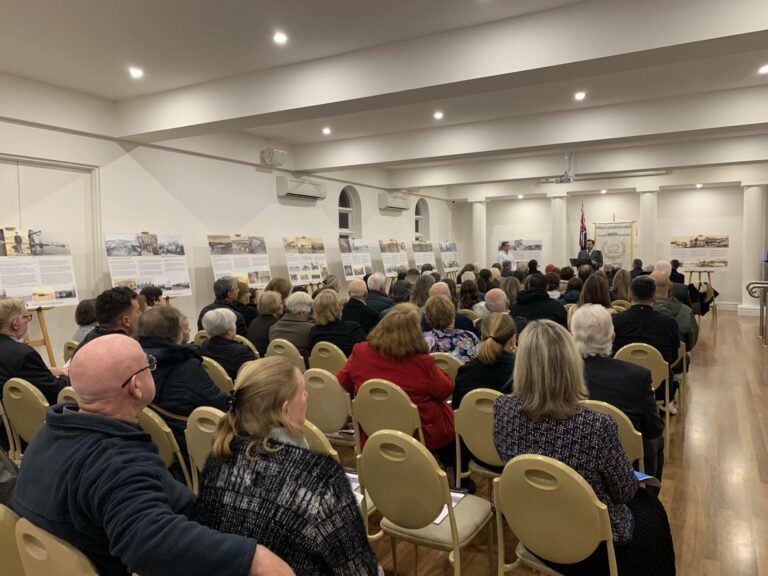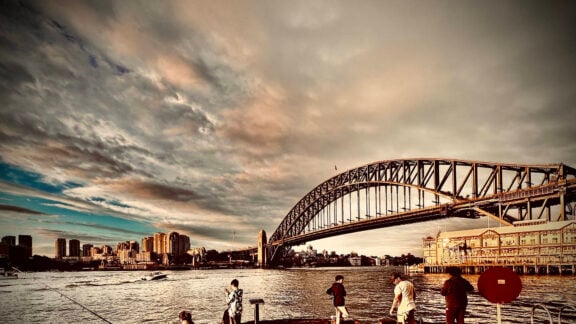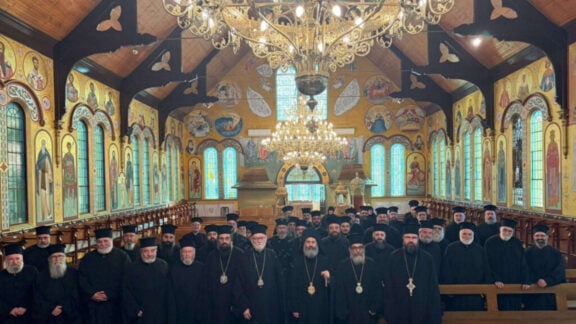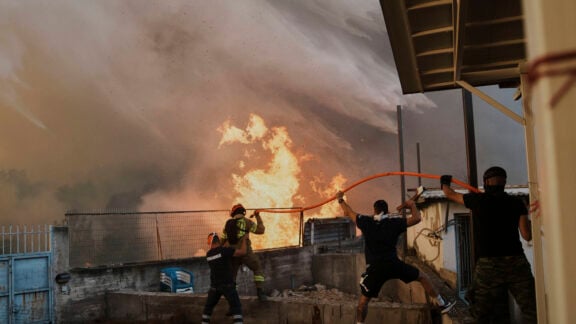A large crowd braved a cold wintry Melbourne night last Friday to witness the formal launch of a new and unique exhibition, depicting the role of the northern Aegean island of Imbros in the Gallipoli campaign and Australia’s Anzac story. The exhibition took place in the refurbished hall of the Archangels Greek Orthodox Church.
During the Gallipoli campaign, the northern Aegean Island of Imbros (modern Gokzeada) was occupied by the Allied forces as part of the Gallipoli campaign. For nearly a year, its overwhelmingly Greek orthodox population played host to tens of thousands of Allied soldiers, sailors and airmen as they transformed the island’s south-eastern coastal area and nearby hinterland into one of the major military and naval bases for the campaign.

The exhibition was organised by the Imvrians’ Society of Melbourne, with the support of the Victorian government, the Victorian Veterans Council, Kingston City Council and others. Jim Claven was engaged by the Society to work with its project coordinator George Xinos in its realisation. The fruits of their labour was on show for all to see.

Claven devised the exhibition into a series of themes, each represented by one or more display panels, each reproducing a number of archival photographs or artworks as illustrations to the accompanying text which draws on the written archival records of the campaign. Claven selected these photographs, artworks and writings based on his years of research.
Claven has been researching Imbros and its connection to Gallipoli for nearly a decade, in the archives in Australia and the United Kingdom as well as through field research on the Island itself. Imbros performed an essential role in the campaign and its people were directly impacted by it.

The exhibition and accompanying guide revealed this role through the depiction of the infrastructure of the military base, the naval vessels in Kephalos Bay, the many types of aircraft based there, the Australian bakers hard at work, the soldiers marching to and from their camps – and in the burials at its Allied cemetery. And there is also a distinctly Australian aspect to this story.
Claven believes that one of the most important aspects of this connection is in the interaction of the locals with these new arrivals. They came together as the Imbrian’s offered fresh food and other goods for sale to the eager soldiers and sailors whether from the caique boats in Kephalos Bay, as the visitors came ashore or as they traversed the Island visiting its villages and appreciating its abundance and natural environment.

“This can be seen in the photograph by Private John Rogers from Wonthaggi of Australian soldiers playing with local village children, in that of a local priest from Panagia (modern Gokzeada Town) visiting the Allied base at Kephalos, in others of soldiers riding hired donkeys across the island including New Zealand-born Lieutenant Alfred Shout from Sydney, and in the beautiful images taken at Castro (modern Kalekoy) by Australian war correspondent Philip Schuler from Hawthorn,” Claven said.

In introducing the exhibition Claven pointed to his own journey through the many written archives and photographic collections which detail Imbros’ role in Gallipoli. Some of the more intriguing discoveries he unearthed, include the Allied map of Kephalos Bay in the National Archives in the United Kingdom, the fascinating personal collection of photographs taken by British Petty Officer Bill Pollard held by the UK First World War Aviation Society and the writings of Australian soldiers who came to Imbros including Second Lieutenant Theodore Taylor from Kalgoorlie and Lance Corporal William Hastings of Perth, the former preserved in his Battalion war diary the latter in the archives of a Western Australian newspaper.

The story of Imbros and Gallipoli, with its various themes and aspects, extends and complements Jim Claven’s previous research into Lemnos and its role in Gallipoli culminating in his book, Lemnos & Gallipoli Revealed.
The exhibition was formally launched by Lee Tarlamis MP, representing the Victorian government and Victorian Veterans Council. Tarlamis said that the exhibition touched him particularly as his own heritage is from Lemnos. He stated that projects such as this were vital to creating a new awareness of the service of our veterans, connecting our diverse community with our shared Anzac story.

Speakers included Melbourne’s Consul-General of Greece Emmanuel Kakavelakis who reflected on the history of Imbros, its diaspora and its connection to Australia. President of the Greek Community Bill Papastergiadis was also present, who found that many of the images of Imbros from 1915 resonated with those of his own Pontian heritage. He also made the point that as Hellenes in Australia, the exhibition reminds us all that before the great wave of post-WW2 Greek migration to Australia, many Australians had already come to the lands of our birth and heritage, such as Imbros. The Hellenic-Australian connection is very much a shared connection in both directions.

Cr Steve Staikos spoke on behalf of Kingston City Council remarking on the importance of Imbros to the Gallipoli campaign, whether as a place of rest or as a source of sustenance. The exhibition was also blessed by the Father Panagiotis Zoumboulis.

Other guests in attendance included RSL Victorian Branch President Dr Rob Webster OAM, Oakleigh Carnegie RSL Sub-Branch President Doug Pendergast, Hellenic RSL Sub-Branch Secretary Major (Retd) Terry Kanellos OAM, Kingston City Council Cr Tracey Davies and historian and author Pam Cupper. Also present were the former president of the Australian Federation of Pontian Associations Simela Stamatopoulos, Greek Australian Cultural League President Cathy Alexopoulos, Krithian Association President Kris Stamboulidis, Hellenic Writers Association President Roma Siachos, Lemmos Gallipoli Commemorative Committee Vice President Christina Despoteris OAM, Tenedos Association Committee Member Sophie Arvanitou and former President of the Lemnian Community of Victoria Phillip Diamataris. A special guest on the night was Ann Holland, the granddaughter of Sapper Alec Holland who came to Imbros as an Anzac in 1915, his painting of the Island featuring in the exhibition.

Many in the audience were moved by the unique photographs on display, some identifying the villages depicted, prompting others to re-tell the stories their parents told them of the day the Gallipoli campaign came to Imbros. Former Imvrians’ Society president Stelios Okoumousis remembered his father telling him of Allied soldiers playing with children, giving them coins and sweets. For the many Imbrians and those of Imbrian heritage, the exhibition was a moving occasion to remember Imbros.
George Xinos spoke of the importance of the exhibition to the Imvrians’ Society and its members. “Here we can all see our Island in a different light”, he said.
“The photographs of the Allied service personnel who came to Imbros in 1915 depict the island as they saw it, as they experienced, with images that that have hardly been seen or appreciated by the public,” George concluded, and thanked all the funders and supporters of the project, with a special mention for Jim Claven.

“Many have called Jim a true philhellene. But I would like to add the title of friend of Imbros. His dedication to this project, to ensuring that it remained true to the historical record, based on the archives in Australia and overseas, has resulted in an evocation of Imbros and its role in Gallipoli that we can all be proud. Thank you Jim”, he concluded.
The launch concluded with presentations to the speakers by the president of the Imvrians’ Society Arthur Pinirou as well as the president of the Parkdale Church Parish Chris Toulmos, followed by the serving of traditional Imbrian foods, all prepared by the women of the Society.
Society Secretary Kaye Lafyati and Vice President Gina Asimoglou made some concluding remarks in support of the exhibition.
The exhibition is planned to be shown at various other venues, details to be confirmed soon. The Society is also keen to hear from other like minded organisations who may be interested in displaying the exhibition, both across Australia and overseas. They are also planning to discuss its showing on Imbros itself.
Xinos also expressed the hope that the exhibition would be the start of a conversation, a raising of awareness and increase in knowledge, that might one day see the creation of an Imbros and Gallipoli Remembrance Trail, identifying and linking the key locations on the Island and encouraging those who visit Gallipoli to take the short ferry trip across to Imbros.

“This expansion of commemorative tourism on the Island can only benefit all the residents of Imbros as well as to those who would walk its Anzac trail and discover the beauty and rich history of the island”, he said.
The exhibition is complemented by an accompanying 132 page exhibition guide book, written by Claven, which tells the Imbros-Gallipoli story in more detail, with references for further reading and illustrated with 80 photographs and 3 original maps from the exhibition.
Those wishing to see the exhibition, organisations wishing to display it, those wanting to obtain the exhibition guide or support the creation of Imbros’ Remembrance Trail should contact either George Xinos at georgexinos@gmail.com – or Jim Claven at jimclaven@yahoo.com.au.








